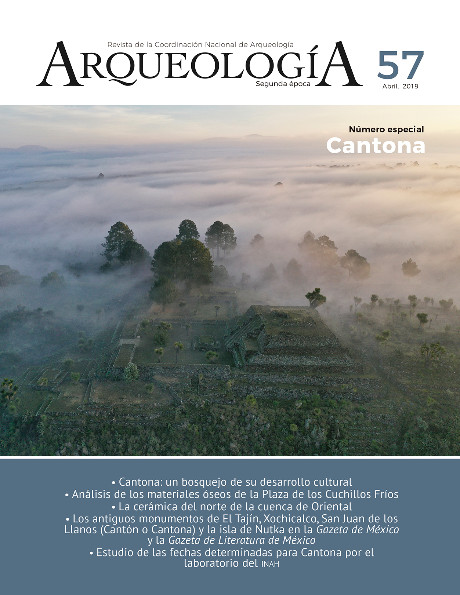Estudio de las fechas determinadas para Cantona por el laboratorio del INAH
Keywords:
Cantona, radiocarbon dates, habitational intervalsAbstract
This paper presents the dates that the Dating Laboratory of the National Institute of Antthropology and History determined, through carbon analysis 14, for samples from: El Palacio, Plaza Central, Plaza Oriente, ball game sets 5, 6, 7, 15 and 23 , yards 6, 9, 22, 24 and 1445B, and several units (27) of the Cantona Project. Initially, when the 190 dates obtained from the project were taken into consideration, the peak of Cantona
was placed between 150 BC and AD 650, but later, after discarding dates from doubtful contexts, it was modified to between 150 BC and AD 425. The calculated habitational intervals for the structures with the greatest number of dates are also shown.
Downloads
References
1995 Radiocarbon calibration and analysis of
stratigraphy: the OxCal Program. Radiocarbon,
37 (2): 425-30.
1998 Probability and dating. Radiocarbon, 40 (1):
461-74.
2001 Development of the Radiocarbon Calibration
Program. Radiocarbon, 43 (2A): 355-363.
2009 Bayesian analysis of radiocarbon dates.
Radiocarbon, 51 (1): 337-360.
Bronk Ramsey, C., y Lee, S.
2013 Recent and planned developments of the OxCal
Program. Radiocarbon, 55 (2-3): 720-729.
Buck C. E., Christen J. A., y James G. N.
1999 BCal: an on-line Bayesian radiocarbon
calibration tool. Internet Archaeology, 7.
Recuperado de: <http://intarch.ac.uk/journal/
issue7/buck/>.
García Cook, Ángel
2003 Cantona: la ciudad. En W. T. Sanders, A. G.
Mastache y R. H. Cobean (coords.), El urbanismo
en Mesoámerica (vol. 1, pp. 312-363). México,
INAH / Penn State University.
2004 Cantona: ubicación y generalidades.
Arqueología, 2a época. (40): 115-152.
García Cook, Ángel, y Martínez Calleja, Yadira
2008 Las vías de circulación interna en Cantona.
Arqueología, 2a. época (38): 125-160.
García, E., Vidal, R., Tamayo, L., Reyna, T. et. al.
1975 Climas: Puebla-Tlaxcala. México,
Cetemal / Presidencia de la Républica.
Jáurequi, Ernesto
1968 Microclima de la región Puebla-Tlaxcala. México,
IQ-UNAM.
México Desconocido
2010 Cantona, ciudad fortificada en
Puebla. Recuperado de: <http://www.
mexicodesconocido.com.mx/cantona-ciudadfortificada-
puebla.html>.
Reomer, P. J., Bard, E., Bayliss, A., Beck, J., Blackwell,
P. G., Bronk Ramsey, C., Buck, C. E., Cheng, H., Edwards,
R. L., Friedrich, M., Grootes, P. M., Guilderson, T. P., Haflidason,
H., Hajdas, I., Hatté, C., Heaton, T. J., Hogg,
A. G., Hughen, K. A., Kaiser, K. F., Kromer, B., Mannin,
S. W., Niu, M., Reimer, R. W., Richards, D. A., Scott, E. M.,
Southon, J. R., Turney, C. S. M., y Plicht, J. van der
2013 IntCal13 and Marine13 radiocarbon age
calibration curves 0-50000 years cal BP.
Radiocarbon, 55 (4): 1860-1887.
Stuiver, M., y Reimer, P. J.
2016 Calib Radiocarbon Calibration Program.
Zamora Rivera, Mónica
2004 Ubicación, descripción y análisis de los juegos
de pelota en Cantona, Puebla. Arqueología, 2a
época. (34): 62-74.



